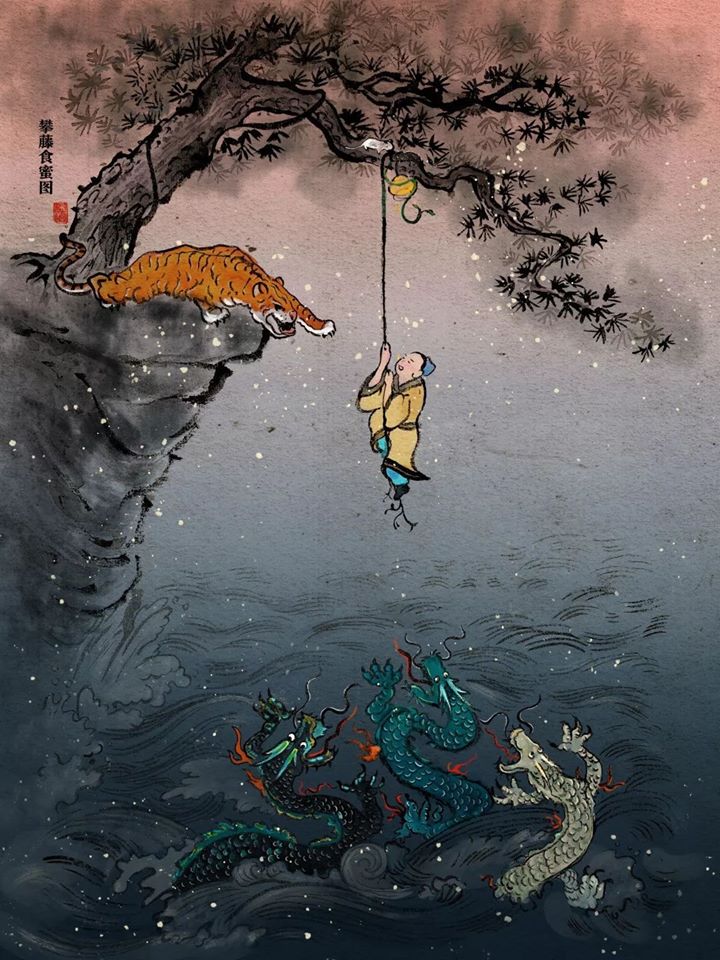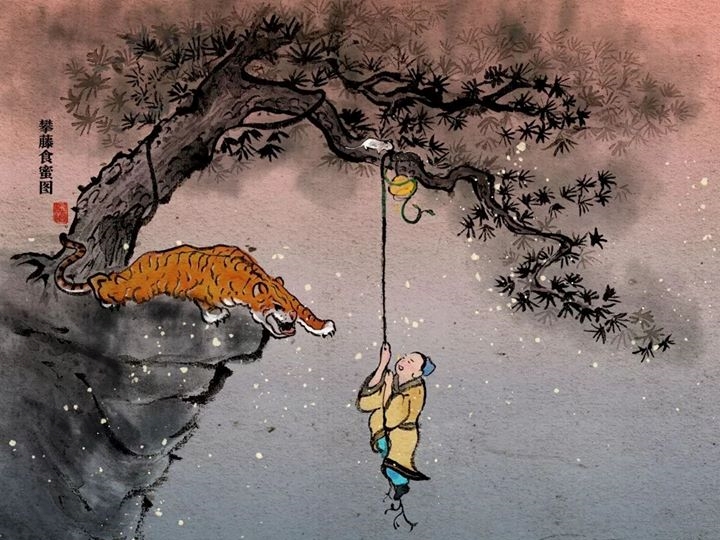Translated by the Pure Land Translation Team; edited by Householder Fojin. From purelandbuddhism.org
By Master Huijing
In the Buddhist Parable Sutra, Shakyamuni Buddha explained to us “What exactly is life?” with a famous metaphor. The metaphor is like this.
On a lonely autumn evening, in the endless wilderness, a traveler hobbled on his way. Suddenly, in the dim light, he noticed some white pieces scattered on the path. On closer look, they turned out to be white human bones.
He was confused and pondering this when there was a startling roar in front of him and a big tiger charged out. Seeing the tiger, the traveler suddenly discerned the cause of the human remains and immediately fled and ran back where he came from.
But he got lost and ran up to the edge of a cliff. There was no way to turn but fortunately he found a pine tree above the cliff, and a vine dangling from the branches. Without hesitation, he immediately grabbed the vine and dangled himself down, narrowly escaping death.
The tiger roared above the cliff in frustration as he saw that the hard-won meal he was about to eat had just escaped. “Thank GOODNESS! Thanks to the help of the vine, a precious life has just been saved.” The traveler felt temporarily at ease but, when he looked below his feet, he couldn’t help but cry out nervously, realizing that below him was a sea with an unknown depth and big waves. Waiting for him in the waves of rage were three poisonous dragons with their mouths open waiting for his fall. The traveler trembled in fear.
But what was even more frightening was that there were two rats, one white and one black, gnawing at the life-saving vine’s root. The traveler shook the vine desperately, trying to drive away the rats, but they did not run away at all. And every time he shook the vine, liquid droplets fell from it, which was honey dripping from a hive on the branch. The honey was so sweet that the traveler completely forgot that he was in a dangerous life-threatening situation. His mind was completely distracted by it.
The parable of this foolish traveler is the reality of all human lives. So, what does Shakyamuni Buddha infer?
Shakyamuni Buddha’s discourse about the “Impermanent Tiger” is to teach the reality of life.

1. Lonely Soul
Traveler: The traveler refers to us.
Wilderness: The endless and lonely wilderness is a metaphor for our endless lonely lives.
When we were born, we became travelers embarking on the journey of life.
As a traveler must know his destination, we too must know our purpose for being born into this world. If we don’t, won’t we be the same as this foolish traveler?
Autumn dusk: Autumn dusk is a metaphor for a lonely life. Why is our life like the loneliness of autumn? Because we travel alone. Although we have relatives, families, and friends, to whom can we pour out everything from the bottom of our hearts and who will be a true soul mate? Even couples cannot fully understand each other throughout their lives. The reason for the loneliness of life lies in the loneliness of the soul. Haven’t you ever been lonely?
White bones: White bones on the side of the road reference the death of family, relatives, friends, etc. on our journey of life. As we are growing up, we see a lot of “white bones.” What was on our mind when we saw them? How did we feel? Have we ever noticed the “impermanent tiger” that’s getting closer?
Tiger: The hungry tiger is metaphorically our death.
Everything in the world is impermanent, so we must die. Death is the scariest thing for us, so Shakyamuni Buddha uses the fearsome tiger as an analogy. Now, this impermanent tiger is forcefully charging towards us, but we don’t want to think about it as it’s a terrifying and ominous thing. And if we feel gloomy and disgusted by Buddhists’ frequent talk about death and determination to face death directly, this is a complete misunderstanding of Buddhism.
Although we try to forget and escape death, it’s bound to come. This escapist mentality cannot solve the problem of dying. Only by facing death head-on, and getting a solution, can we gain absolute peace of mind and happiness. That’s why Buddhism discusses death. As travelers, we instinctively want to escape from death. We go to the hospital as soon as we are sick or use medicine to fight death, but death is still an inescapable boundary.
2. The fragile pine tree
Pine Tree: Climbing to the top of the pine tree at the edge of the cliff refers to clinging to money, property, reputation, status, and so on. However, no matter how rich we are, these material things are still useless in the face of death. Even Emperors Qin Shihuang and Han Gaozu, with their great historical achievements, could not help but exclaim “Oh! Life is like a dream” and died lonely.
Can we greet death with a smile by holding gold and silver, property, reputation, status, etc.? When we are on the verge of dying, we can’t take anything with us, so it’s impossible to smile at death.
3. Life is a dream
Vine: The metaphor of the vine is “Not yet!” Not yet! I won’t die yet.” I think I have twenty or thirty years to live, but even if you think “I have ten or twenty years to live”, what do you think is your life expectancy? Think about it and you will know that the past ten or twenty years have disappeared like a dream between the sound of exclamations “Oh”. And the next ten to twenty years will also pass between the same “Oh” exclamations.
Rats: The white and black rats that constantly bite the vines refer to day and night. Day and night pass by shortening our lives. As they say: living through today also means today has died. Aging doesn’t stop even when we are celebrating the New Year, festivals, or holidays. And so, in the end, the vines will be broken by the constant biting, just as “death” will come.
4. The major after-life event
Everyone in life is passing through. Even if we are together for a hundred years, it is still all a dream.
We can’t take anything with us into our coffins. We will all face King Yama empty-handed.
Like the traveler, our fate is to fall to the poisonous dragons in the bottomless sea. Because, after we die, there must be “a great afterlife event”.
Deep Sea: The metaphor of the deep sea is “hell”. If you fall into hell, you must endure the “great sufferings for eighty thousand kalpas”, which is called “the major afterlife event”.
Once you have fallen into hell, you are stuck for eighty thousand kalpas. When will you be reborn in the human realm?
Poisonous Dragons: The pain of hell is shown by these three poison dragons, which represent the horrible heart filled with greed, animosity, and ignorance.
Due to “greed,” we don’t know how many evil crimes of killing, stealing, lewdness and lies we have accumulated in our minds.
Due to “animosity,” we don’t know how many sins of “cursing others to death” we have accumulated in our minds.
Due to “ignorance,” we don’t know how much resentment towards our misfortune and jealousy of others’ happiness we have accumulated in our minds.
There is no mistake in the law of cause and effect: “a good cause brings a good effect, an evil cause brings an evil effect, and we bear the fruits of our own actions. Our constant evil acts build the hell that we will fall into one day.
It is Buddhism that teaches us how to solve the problem brought by the major afterlife event. But, as travelers, we forget the deep sea and dragons (the great afterlife event) right under our nose, and our minds are completely stolen by honey.
Honey: Honey refers to a human’s five desires: wealth, lust, fame, gluttony, and sleep. Throughout the day, what we keep thinking about and craving for is nothing more than how to satisfy these five desires.
But isn’t it very foolish to keep licking honey and falling unknowingly?
Can we deny that we are not like this traveler?
Shakyamuni Buddha hereby shows us the true nature of our lives — that is, the “major after-life event” is approaching every moment. — and shows us the solution.
Come on! Don’t run away from death. We must face it directly.
Only by solving the problem of death can we truly gain absolute peace of mind and fulfillment.
We are the only ones who can open the door of peace of mind offered by Buddhism However hard it is to be born as a human, we have been.
However difficult it is to encounter Buddhism, we have done so.
In which lifetime are we waiting to be emancipated if not this one?


